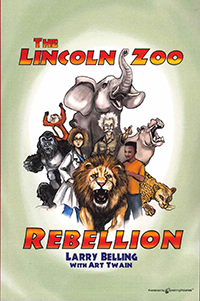The Lincoln Zoo Rebellion by Larry Belling with Art Twain; Naples, Florida: Speaking Volumes, LLC © 2924; ISBN 9798890-220363; 215 pages; $14.95,

 SAN DIEGO – The late Larry Belling and Art Twain were friends from the time of their youth. Belling was an alum of the now defunct UC Berkeley chapter of the Jewish fraternity Kappa Nu, who went on to become a press agent for Broadway plays and a producer of radio commercials for such clients as American Express and Molson Beers. In 2014 he wrote his first play, Stroke of Luck, about an invalid telling his three middle-aged children that he plans to marry his nurse, and their efforts to save their inheritances by blocking the marriage. Belling also narrated documentary films for the Discovery Channel and National Geographic, among others.
SAN DIEGO – The late Larry Belling and Art Twain were friends from the time of their youth. Belling was an alum of the now defunct UC Berkeley chapter of the Jewish fraternity Kappa Nu, who went on to become a press agent for Broadway plays and a producer of radio commercials for such clients as American Express and Molson Beers. In 2014 he wrote his first play, Stroke of Luck, about an invalid telling his three middle-aged children that he plans to marry his nurse, and their efforts to save their inheritances by blocking the marriage. Belling also narrated documentary films for the Discovery Channel and National Geographic, among others.
Twain, who handled marketing for such accounts as Levi’s and the Gap, collaborated with Belling on a kids’ novel, The Lincoln Zoo Rebellion, in which elderly zookeeper Reggie Goodenough, like the legendary Dr. Doolittle a century before him, befriends and communicates with the animals, sometimes by talking, other times by just mentally concentrating. He has learned many animal languages in the process.
In this novel, the adult human characters are either good or bad, with few shades of gray. The animals, of course, are all good, although sometimes they can’t restrain their natural urges. The behavior of the children improves over the course of the novel, as they come to understand what is at stake.
Ralph Throttlebottom is a wealthy, greedy, toy manufacturer, who builds a factory in the town of Clint East Woods – one of many amusingly named places in this book. The novel at times is silly and fanciful, but along the way teaches about animals and the need for their conservation. Throttlebottom decides he wants to turn the Lincoln Zoo into an amusement park and zoo. When Goodenough objects that the noise from the amusement park rides will scare the animals, Throttlebottom brushes him aside. Animals are not his interest; making money is. In the center of the tourist attraction, he wants to build a giant outlet for his toys.
Throttlebottom leverages his position as the wealthiest man in town to get himself elected as mayor. He and his compliant city council adopt ordinances that benefit the amusement park and his toy company but are to the detriment of the zoo animals and the town’s overall environment.
Things go from bad to worse and eventually Goodenough persuades the zoo animals, including some that Throttlebottom arranged to have imported from Africa, to protest Throttlebottom’s tactics. Matters quickly get out of hand, with Throttlebottom calling on law enforcement to quell the rebellion. The animals utilize their natural abilities to resist in mostly non-violent fashion Throttlebottom and his minions.
Belling died while he and Twain were collaborating on the humorous book so it fell upon Twain to complete it. Twain gave his friend top line credit on the finished product.
The book’s intended audience are children between the ages of 8 and 14. One can easily imagine this being made into an animated film. As a matter of local pride, the San Diego Zoo receives favorable mention in the epilogue.
*
Donald H. Harrison is publisher and editor of San Diego Jewish World.